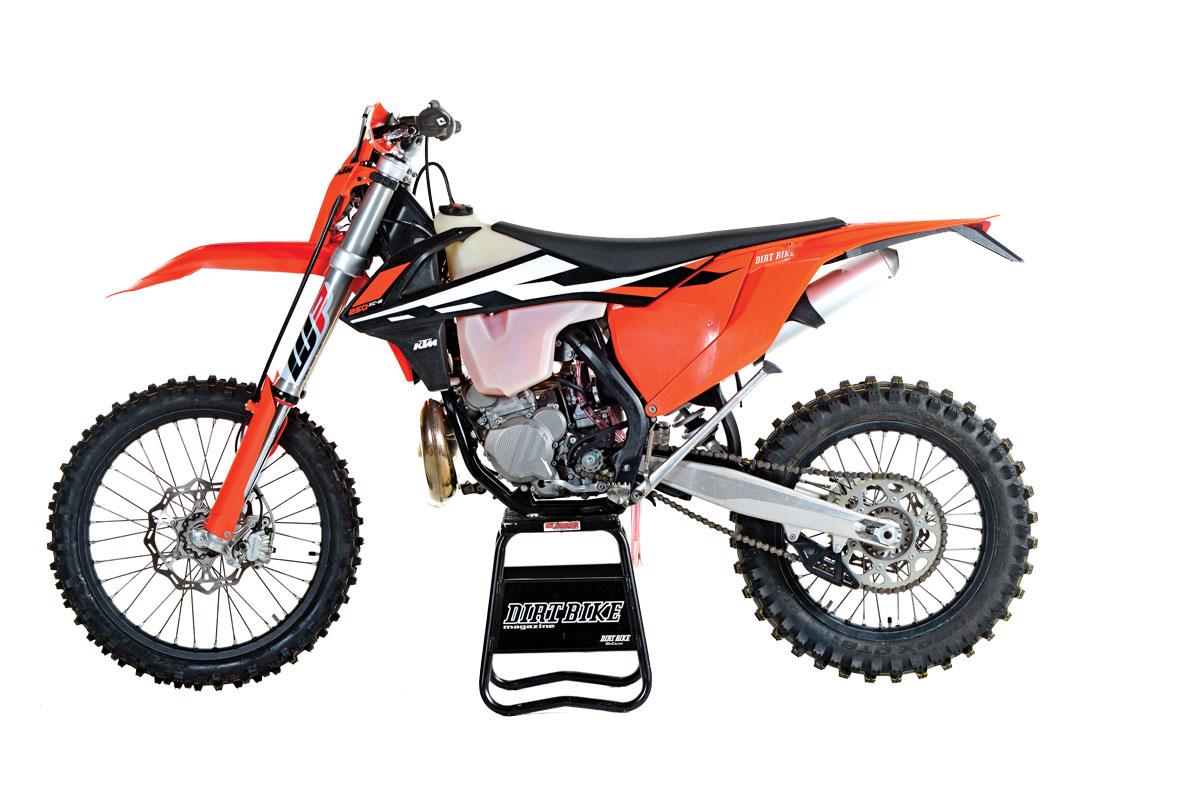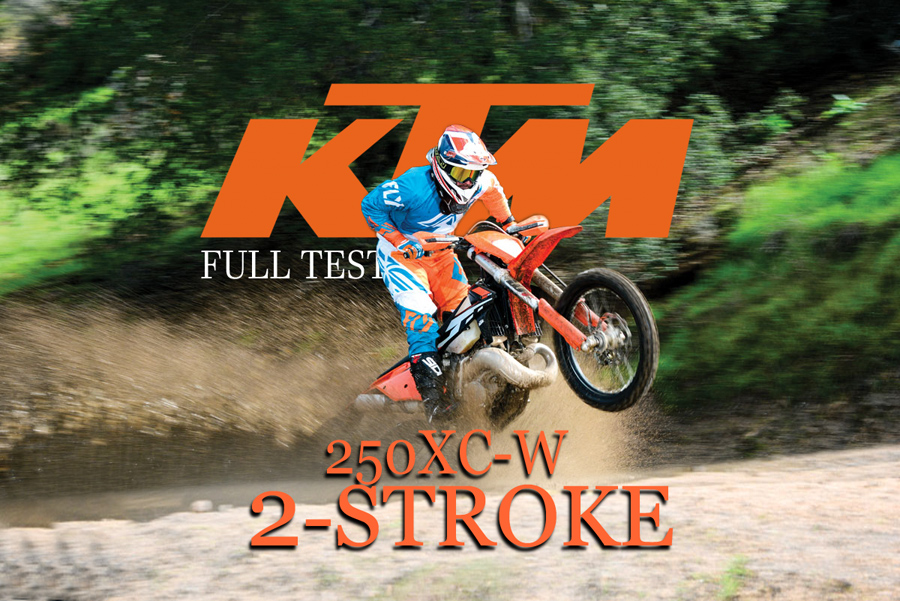There’s a lot of confusion about off-road bikes—what they are and what they should be. Are they the same as MX bikes but with handguards? Are they dual-sport bikes with better tires? Are they bikes with EPA-approved emission and noise?
Stop it. It’s not that hard. If you really want the definition of an off-road bike, here it is: the 2017 KTM 250XC-W is a perfect, textbook example of the breed. It has nothing to do with government certification, corporate identification or marketing direction. It’s all about what a bike can do. The 250XC-W acts like an off-road bike.

BUCKING THE TREND
Regulatory definitions aside, the traditional role of an off-road bike is a motorcycle that’s designed to work anywhere there’s dirt. That includes mountain trails, eastern mud, desert rocks and even the occasional MX track. The reason things have become so blurry is because the federal government wants to regulate broadly defined vehicles like that, so if a manufacturer calls its product an off-road bike, it must be scrutinized and approved. If, on the other hand, a manufacturer calls the same product a “closed-course competition” vehicle, there are no such issues. In the case of the 250XC-W, there’s no possibility it would ever meet government emission requirements. It’s a carbureted two-stroke—end of discussion. That frees up KTM engineers to design the bike as they see fit without compromise. It’s thrown into the same category as a motocross bike for bureaucratic reasons, but it is one of the purest off-road bikes on the market today.
For 2017 KTM made a big investment in a new two-stroke engine. Rather than just leave the existing design alone to live out its years in peace, KTM redesigned everything about the motor. It got a gear-driven counterbalancer. The electric start was relocated to an area under the motor, and it lost weight. The motor has case-reed induction with a Mikuni TMX carburetor. The clutch has a diaphragm spring with hydraulic actuation, and the gearbox is a six-speed. Before the bike was released, there was speculation that it would have fuel injection, at least in Europe. That didn’t materialize, but it still might happen in the near future. In 2020, the new Euro 5 emission testing will be in effect, so KTM probably designed the motor with that in mind. Lars Enockl already rode a prototype, injected KTM two-stroke in the Roof of Africa and the Red Bull Megawatt Enduro. If the production bike does get injected in 2018 or 2019, it won’t be direct injection as we’ve seen in the marine and snowmobile industries—that would require a completely different platform. The first of KTM’s EFI two-strokes will have throttle-body injectors, much like current four-strokes, and these models are unlikely to pass U.S. emission testing. The fact that KTM invested so much in this motor tells us that direct injection won’t come any time soon.
As for the rest of the bike, the XC-W chassis is a little different from anything else in the KTM line, aside, perhaps, from the dual-sport bikes. It has the latest version of the PDS no-link rear suspension with a completely redesigned shock this year. All of the factory off-road riders in Europe use this design. Interestingly, none of KTM’s racers in America do. This bike also comes with a fork that’s new for 2017. The WP Xplor 48 has springs in both legs with preload adjusters in the caps. There’s a compression clicker on the left cap and a rebound clicker on the right.

PERFECT PITCH
Between KTM and Husqvarna, there are nine different U.S. models that use this engine platform. That’s the largest run of a single “motor family” in the company’s history. We’ve already tested a number of them, so we knew we would like it. We just didn’t know how much. The 250XC-W might be the best of the bunch.
As we’ve already discovered, the motor is super smooth. The counterbalancer snuffs out almost all the vibration that we associate with two-strokes. Funny, we never really knew that buzz was there until it was gone. Now, when you go back to an older two-stroke, it’s obvious how smooth the new bike is. In addition to the anti-vibe aspect of the balancer, the balancer shaft lends the motor more spinning inertia, just like a heavier flywheel would. When you combine that with excellent torque and good carburetion, you get a bike that’s unstoppable at low rpm. At the bottom, it’s nearly a trials bike, so no matter how badly you muff up, the bike forgives you and keeps on running. Today’s four-strokes might be better than they once were, but none of them compares to this. The 250XC-W’s low-rpm manners are nothing short of amazing.
As the revs climb, the power just gets better and better. The KTM has an eager-to-go feel, and that willingness spreads to the rider. As we said, we’ve ridden all the new KTM two-strokes now, and this one runs the cleanest and revs the quickest. On the 300, there’s a carburetion glitch right in the middle that’s hard to remedy. The 250 motocross bike has the same thing, in addition to a very sudden surge of power. With the 250XC-W, there’s only the smallest hint of a jetting glitch in the middle. You only notice it if you’re looking for it. It has none of the lean surge that was evident on the 300, and the hit is much smoother and more friendly than that of the MX version. In terms of outright power, the XC-W might surrender a little to the SX, but it’s still in the hunt with the Yamaha YZ250.

OFF-ROAD INGREDIENTS
The motor is only part of the recipe that makes the W such a textbook off-road machine. The bike feels light—very light. It weighs 218 pounds without fuel, which is amazing in itself. That’s lighter than a Yamaha YZ250X two-stroke despite having an electric starter. It’s also lighter than a Husky TE250 because of the KTM’s PDS rear suspension; linkage adds a few pounds. It’s the same story when you compare the XC-W to the Beta 250RR and the Gas Gas EC250. The KTM is the lightest bike in its class. That fact is obvious when you ride it. You feel somewhat invincible, like you can get out of any situation you put yourself in. Drop down a sheer cliff into a ravine you’ve never explored? Sure! It will work out fine. The XC-W excels in extreme situations. Having electric start only makes you more brave. Purists like to say that modern 250 two-strokes start so easily that push-button starting is pure fluff. But, when you’re stalled in a situation where you can’t get to the starter, like a deep rut or the side of a steep hill, the button makes all the difference.
Likewise, if you’ve ever been hung up on a log, PDS suspension is an excellent ally. With no linkage hanging down, it’s just a matter of scooting the bike forward until the rear wheel grabs something. As far as the suspension action itself, the rear end is set up well for off-road work. It’s soft but not mushy. It reacts to small bumps like rocks without excess chassis movement or weight transfer. If you charge into massive whoops, you will bottom out, but not with a hard metal-to-metal impact. It has a good bottoming system, but there’s no question when you’re out of travel. The XC-W is a trail bike first and a racer second.
In the front, the Xplor 48 fork is very impressive. There have been big changes at WP since it was purchased by KTM and moved to Austria. In performance, the Xplor fork is every bit as impressive as the new AER 48 fork that has changed the game for KTM’s motocross bikes. It is, of course, a coil-spring fork, which is much more appropriate for an off-road bike. And, like the rear end, it’s set up on the soft side. In the front, though, bottoming isn’t noticeable. Its spring and damping rates allow it to suck up trail-sized bumps, but it can also deal with crushing impacts surprisingly well. If you take it to a full-fledged motocross track, you will notice a lot of fork dive, but not much else will make the Xplor fork seem out of its element. With the adjustable preload pumped up, you can get away with sportsman-level MX on natural-terrain tracks.

OFF-ROAD CREDS
Back in the days when we could gather five or six 250 two-strokes in an off-road shootout, KTM always came out on top. The company has always known a thing or two about off-road setup, going back to the Penton days. The XC-W has all the right stuff, like good handguards, an O-ring chain, decent waterproofing and a side-access airbox. The hydraulic clutch has an easy pull and excellent feel. The brakes are incredible, and the gear ratios have a great spread. First gear is good for trials-like sections, and sixth will allow the bike to blow past most five-speed 450s in high-speed straights. We know; we raced the bike at the Adelanto GP where there was a mile of pavement for the XC-W to stretch its legs. The only real problem we’ve experienced are broken exhaust pipes. Two pipes broke in the same spot, right where the descending cone joins the stinger. We don’t know if this will be a common problem or if we’re just hard on pipes. So far, we haven’t had the same problem with a Scalvini.
Overall, though, the bike stands out as one of the very best off-road bikes of the year. That’s saying something considering that 2017 has been a big year for off-road hardware, with more motorcycles available than we’ve seen in over 10 years. There are dual-sport bikes and competition bikes crowding into the same space. In all these cases, though, the success of these bikes will be judged on one thing first and foremost: how close are they to being a KTM 250XC-W? o
GOOD GUMBO
• Very light
• Fast enough for racers
• Unstoppable torque
• Electric start with kick-start backup
• Wow! What brakes!
• Hydraulic clutch
• No linkage to drag
• Excellent trail suspension
STALE CRACKERS
• Slight carburetion hitches
• Fragile exhaust pipe
• No spark arrestor
• Gas-thirsty
KTM 250XC-W
Engine type … Electric-start, case-reed,
power-valve two-stroke
Displacement … 249cc
Bore & stroke … 66.4mm x 72.0mm
Fuel delivery … Mikuni TMX38
Fuel tank capacity … 2.5 gal. (9.5 l)
Lighting … Yes
Spark arrestor … No
EPA legal … No
Running weight, no fuel … 219 lb.
Wheelbase 58.3″ (1482mm)
Ground clearance … 14.6″ (370mm)
Seat height … 37.8″ (960mm)
Tire size & type:
Front … 80/100-21 Dunlop AT81F
Rear … 110/100-18 Dunlop AT81
Suspension:
Front … WP Xplor 48 adj. preload/reb./
comp., 11.8″ (300mm) travel
Rear … KYB aluminum piggyback, adj. prld,
hi & lo comp., reb., 12.2″ (310mm) travel
Country of origin … Austria
Suggested retail price … $8899
Manufacturer … www.ktm.com




Comments are closed.